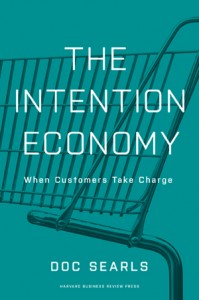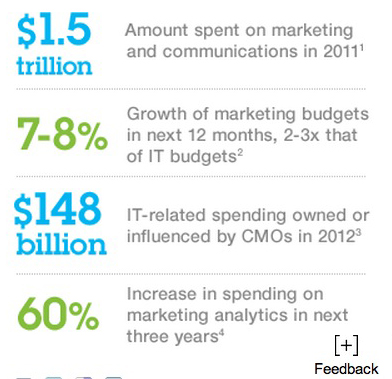 Looks like IBM and I
Looks like IBM and I  are in agreement. Last week the first image you saw at IBM’s site (at least here in the U.S.) was a larger version of the one on the left, with the headline “Meet the new Chief Executive Customer. That’s who’s driving the new science of marketing.”*
are in agreement. Last week the first image you saw at IBM’s site (at least here in the U.S.) was a larger version of the one on the left, with the headline “Meet the new Chief Executive Customer. That’s who’s driving the new science of marketing.”*
At the “learn more” link, the headline reads, “The new CMO and the science of giving people what they want.” In the copy there’s this:
In this highly connected world of commerce and communication, you can no longer market broadly to a demographic. A consumer doesn’t want to be a “segment.” She’s an individual. To capture and keep her business, she must be treated as one.
The onus of this evolution has landed on the doorstep of the Chief Marketing Officer. And that means that the mind-set, as well as the skill set, of a CMO has to evolve right along with it. IBM has identified the three mandates for the new CMO.
The first of those is “Harness data to paint a predictive picture of each customer as an individual—on a massive scale.” The second is “Create ‘systems of engagement’ so you do more than shape desire—you predict it. The third is “Design your culture and brand so they are authentically one.”
Above that last one it says this:
Your brand is tested in every interaction. Today, the same transparency that allows you to understand each customer as an individual; conversely allows each customer to understand everything about your company. And gaps between what the brand promises and what it delivers are known―not just by those who experience them, but by others in their social network. Thus how authentically a culture lives its brand becomes the measure of success. This is the heart of becoming a social business. Marketing’s role is to close the gaps by building a system so that in every interaction brand and culture are one.
Two problems with that. Also two opportunities:
- Transparency isn’t what allows a company to understand each customer as an individual. Direct interaction is. Better yet, direct interaction that the customer drives, in her own way.
- “Becoming a social business” is very 2011. Business was personal in the first place, and it will be personal again. What the hell is a Chief Executive Customer if she doesn’t have direct personal influence with the company?
IBM is familiar with CRM: Customer Relationship Management. Now it needs to get familiar with VRM: Vendor Relationship Management. Because it’s with VRM tools and services that customers will have the means to tell companies exactly what IBM’s headline welcomes: what they want.
Meanwhile, here’s the bad news for Big Data: what customers don’t want, most of the time, is to be told constantly what they want. Or to be told that their Chief Executive status with a company derives from a “predictive picture” derived from “harnessed data” about one’s individual self — least of all “on a massive scale” in which desire is not only “shaped” but “predicted.” IBM continues,
Today’s abundance of data helps companies understand each customer in multiple dimensions. This leads to insights which, when combined, help build a clearer understanding of each customer as an individual. With that, marketers can make better decisions about the mix that will serve customers more completely—based on needs, desire, likely next action, opinions. Today’s marketing practice requires building this capability of understanding customers as individuals across millions of interactions.
There is no clearer sign that a relationship has gone bad than this statement: “We don’t need to talk. I already know what you’re going to say.” Or worse, “I can also shape your desire.” Hell, that’s a relationship headed for divorce, and it’s hardly begun.
But that’s what Big Data marketing is about — so far — and why it will fail if the customer is not truly involved as an independent and autonomous human being, and not just as a “million points of data:+” (IBM’s term), and then as a target for messages and offers, based on the crunching of that data.
On that same page IBM posts this short pile of Big Data stats:
Earth to IBM and CMOs: The next era isn’t social. It’s personal. No amount of marketing analytics will out-perform knowing exactly what the customer wants, intends, or wishes to contribute to the company’s intelligence about the marketplace —in her own ways, and on her own terms.
If a brand wants to be fully understood and respected — and if it deserves both — it needs to be ready for customers to truly engage, and not just be told what they’re like, and then guessed at.
The means for that will be provided by both sides, not just by one. Until IBM and CMOs welcome independent customers, operating at full agency, outside any company’s silo or walled garden, all this mandating will be the sound of one hand shaking.
*The links have 404’d or changed. Here’s what I can find in March, 2016:
- Smarter marketing/Chief Executive Customer (2012)
- Age of the Chief Executive Customer (2014)
- Welcome to the Era of the Chief Executive Customer (download required)

Leave a Reply